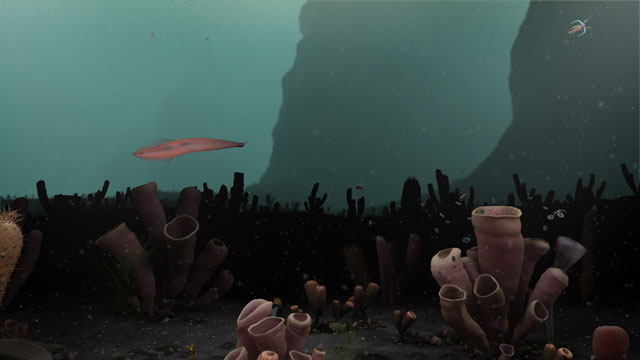Reinterpreting the Burgess Shale Deposits
New research suggests that the remarkable Burgess Shale deposits may not preserve the remains of a single, complex Cambrian marine ecosystem but the animals that were to become preserved as fossils may have been transported to this location from much further away.
A New Research Paper Focusing on the Burgess Shale Deposits
Researchers led by Dr Nicholas Minter and Dr Orla Bath Enright (University of Portsmouth), writing in the academic journal “Communications Earth & Environment” postulate that the amazing biota associated with the Walcott Quarry could have undergone substantial transport prior to deposition. They suggest that this aggregation of fossils of primitive marine creatures might not represent the remains of a single, rich and diverse ecosystem but the accumulated remains of several prehistoric communities.

Ancient Lifeforms Moved by Mudflows
In late August 1909, American palaeontologist Charles Walcott was exploring an area of shale deposits exposed in the mountains of British Columbia close to Mount Burgess. He discovered a profusion of fossils in the shales, many of which had their soft parts preserved. The strata consist of fine mud which were laid down between 510 and 505 million years ago and the location, now known as Walcott Quarry, was declared a UNESCO World Heritage site in 1984.
More than 65,000 fossil specimens have been collected representing more than 120 species. This fossil assemblage helped to support the theory of the “Cambrian explosion”, that towards the middle of the Cambrian there was a sudden burst of evolutionary activity leading to the evolution of the Phyla we have today. It had been thought that this Lagerstätte had been formed when catastrophic mudflows buried the ecosystem but the researchers, using flume experiments were able to demonstrate that the remains of delicate animals were capable of being transported tens of kilometres.

Taphonomic Assessment and Analysis of the Burgess Shale Deposits
The researchers used a combination of measurements and assessments at the Walcott Quarry site with flume tank laboratory tests to mimic the mudflows and the deposition. They concluded that the delicate bodies of certain creatures could have been moved over tens of kilometres without damage, creating the illusion of this Lagerstätte representing a single prehistoric community.

The Deterioration of the Remains of Polychaete Worms
The University of Portsmouth was assisted in this research by scientists from University of Saskatchewan and Southampton University. They looked at one particular species of polychaete worm (Alitta virens) present in the shales, classified the degree of preservation for fossil specimens from entire/complete to degraded with just jaws and setae (bristle-like structures) left. They concluded that transport of the carcasses of these delicate animals did not significantly damage the remains further beyond what has already occurred due to normal decay processes.

Commenting on the implications this study might have Dr Bath Enright stated:
“We don’t know over what kind of overall time frame these many flows happened, but we know each one produced an ‘event bed’ that we see today stacked up on top of one another. These flows could pick up animals from multiple places as they moved across the seafloor and then dropped them all together in one place”.

A Cautionary Note
This research indicates that the transportation of the remains of soft-bodied creatures does not unduly affect their degradation. Fossils found in a single layer of sediment and assumed to represent animals living together in a single ecosystem, could actually represent the accumulation of remains that have been gathered together and that these animals may have lived far apart. The study provides a cautionary note on how palaeontologists develop views on ancient ecosystems based on the fossilised remains of the creatures they study.
Intriguingly, for what appears to be such a rich and specious community, dominated by benthic organisms (living on the seafloor), there is very little evidence of trackways, burrows or bioturbation associated with this famous fossil site. The lack of these trace fossils suggests a predominantly low oxygen or anoxic habitat and this lends weight to the idea that the sediments in which the fossils were found do not represent the habitat of these creatures.

What Caused the Mudflows?
It is not known precisely what caused the mudflows which buried and transported the animals which became fossilised, but the area was subject to multiple flows, causing well-preserved fossils to be found at numerous different levels in the shale.
Dr Bath Enright added:
“When we see multiple species accumulated together it can give the illusion we are seeing a single community. But we argue that an individual ‘event bed’ could be the product of several communities of animals being picked up from multiple places by a mudflow and then deposited together to give what looks like a much more complicated single community of animals”.
The scientific paper: “Flume experiments reveal flows in the Burgess Shale can sample and transport organisms across substantial distances” by Orla G. Bath Enright, Nicholas J. Minter, Esther J. Sumner, M. Gabriela Mángano and Luis A. Buatois published in Communications Earth & Environment.
The Everything Dinosaur website: Prehistoric Animal Models.

